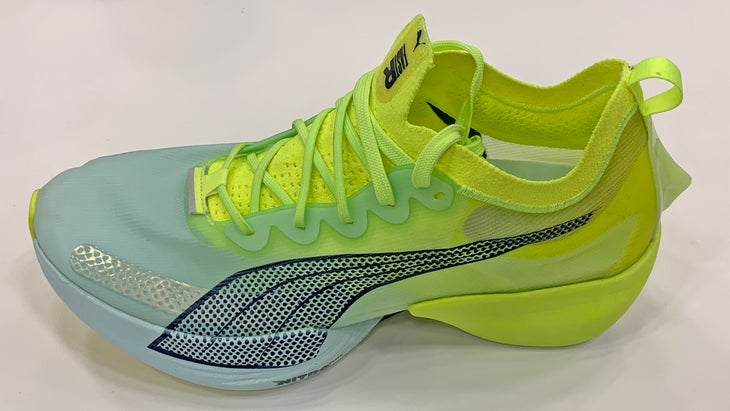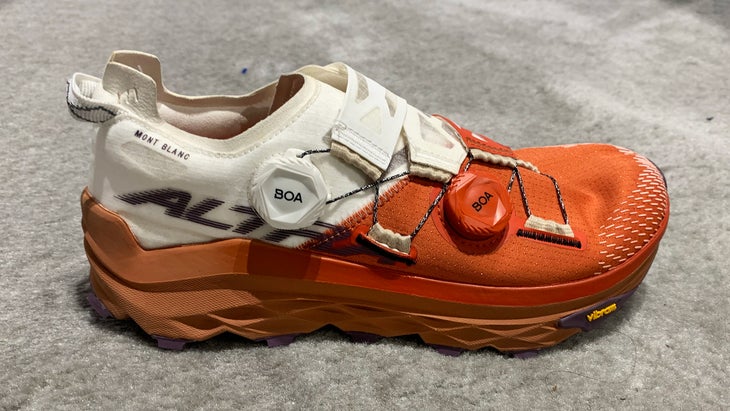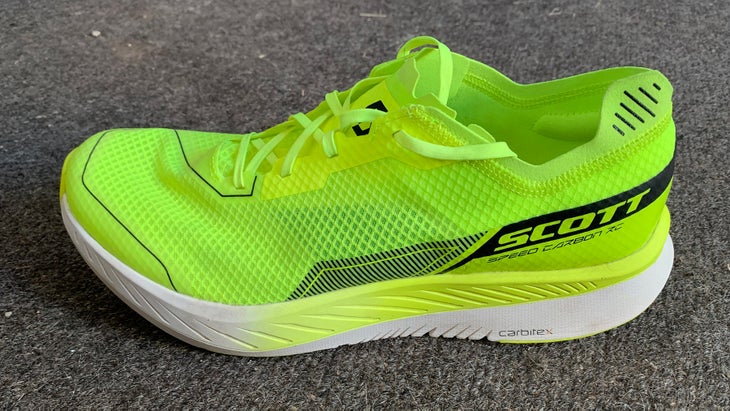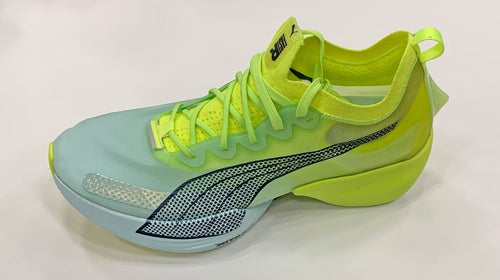As the new year rapidly approaches, running-shoe companies are dropping hints about the technologies and designs they plan to roll out in 2022. Based on what we’ve seen, it promises to be a banner year for running footwear, with refined tech pushing the limits at the top end and trickle-down innovations appearing across categories and price points. Here are a few models that we’re most excited about training and racing in.
Puma Fast-R Nitro Elite ($250)

Evolving the Super Shoe
Easily the most eye-catching shoe promised in the new year, the Puma Fast-R is a novel evolution of the marathon racer that wore to a bronze-medal finish in this year’s Olympic marathon. The Fast-R features all the familiar ingredients of : ultralight construction (seven ounces), a thick stack of energetic foam (38 millimeters in the heel, 30 millimeters forefoot), and a rigid, curved carbon-fiber plate. But it takes the recipe to a new level by decoupling the heel from the forefoot and making each segment from a different foam: under the forefoot, a bio-based Pebax provides the über-bouncy, propulsive rebound we’ve come to expect from high-stack racers, while beneath the heel is a soft EVA blend designed to absorb shock and stabilize your stance, avoiding the wobbly landings experienced in many super shoes.
“Allowing heel and forefoot to work independently, it lets the body attenuate shock, then turns into a powerful toe-off,” says Todd Falker, the brand’s senior product-line manager. According to Falker, lab testing revealed that the quick stabilization reduced muscle contraction and increased efficiency. Puma also refined the plate’s stiffness so that “it works with your foot—bending just the right amount in just the right places,” he says. Both the stable heel and slightly flexible plate should make the ride more accessible to non-Olympic runners. Based on the sweet, smooth ride of Puma’s first super-shoe attempt, we’re chomping at the bit to try this refined model. A limited few will be released in February, but if you’re not a marathon podium candidate, you’ll probably have to wait until the larger launch in June.
Altra Mont Blanc ($180; $210 with BOA Fit System)

Taming Trails with Strategic Simplicity
Altra’s shoes achieve stability through a balanced, zero-drop platform combined with a wide toe box that lets your foot spread out and support your stance naturally. This allows the brand to use soft, bouncy foams, rather than stiff platforms and rigid control devices. We’ve loved the ride of Altra’s Paradigm 6, which is built on 30 millimeters of its lightest and most responsive foam. The midsole sinks in and contours around your foot before firming up and bouncing back, providing a unique combination of cushion, ground feel, and lively responsiveness, with unobtrusive control delivered by guide rails that wrap up around both sides of the rear foot.
The new Mont Blanc marries that shape, foam, and ride with a light, unstructured but tightly woven upper, and a thin, grippy trail sole with varied lugs in strategic locations. The result is a long-distance trail-racing shoe that Altra cofounder Brian Beckstead says is “shockingly light and nimble, while still surprisingly stable.” The 31-millimeter stack height puts it between the Timp and Olympus in the , but it compares with the brand’s lower-stack Lone Peak in weight, coming in at 10.5 ounces for a men’s size nine. Given its premium midsole foam, outsole rubber, and ripstop upper mesh, however, Beckstead maintains that “as much as it is a light racer, it will be very durable for training or to tackle 100-milers.” A version with laces will come out in March, but you might want to hold out for the May release of the dual BOA version, which will allow you to precisely dial in the desired tension across your midfoot and toe.
Saucony Endorphin Edge ($200)

Adapting Carbon Fiber for Tricky Terrain
In 2021, the North Face’s stood alone as the only carbon-fiber shoe for the trail. In 2022 it will have lots of company: at least four brands are rolling out their own version of a trail super shoe. Each plays with the plate’s shape and stiffness, the foam composition, and the rocker geometry in different ways to promote propulsion without compromising the flexible stance required on variable terrain. While we’re anxious to run in all of them, the one we’re most intrigued about is the Endorphin Edge.
Saucony designers used the same light, soft, trampoline-like foam found in the Endorphin Pro and Speed road racers, but it added width to increase stability and moved the start of the rocker forward slightly to enable a solid stance on the trail before rolling quickly off the toe. What’s inside that rocker promises to make the most difference: Saucony worked with carbon-fiber manufacturer Carbitex to design a Y-shaped, curved carbon-fiber plate that bends upward from the toe but not down. Thus, the plate still acts as a stiff lever when pushing off, but it flexes with your foot through the roll of the stride, keeping you connected and engaged with the trail. Plus the flex allows the independent prongs of the plate to give way when pushed up by uneven terrain, rather than turning your foot sideways as a full rigid plate would. Beneath the midsole, a full-length, light, flexible rock guard made of carbon-poly mesh provides additional protection without adding much weight—the shoe tips the scale at only nine ounces in a men’s size nine, lighter than the brand’s popular and more minimalist Peregrine trail shoe. The Endorphin Edge looks like it will deliver a speedy, adaptable, and protective ride for light-footed runners, but you’ll have to wait until August to tear up the trails in it.
Scott Speed Carbon RC ($190)

Customizing Plate Stiffness for the Rest of Us
One of the problems with making a super shoe for the masses is that to optimize performance you have to fine-tune each element—foam rebound, rocker shape, plate curvature, and stiffness—to a certain speed, weight, and stride. Thus, a shoe that makes one runner fly will produce a clunky ride for another. Each runner is left to try every $250 to $300 model to determine what works best for them. Then there’s the fact that few of these super shoes are ideal for four-hour marathoners.
Enter the from Scott, a storied company in outdoor sports but still little known for its running shoes. Designers employed a different kind of carbon plate that increases in rigidity as more force is applied to it, promising to optimize your push-off with a custom-tuned stiffness that adjusts not only for your size and stride but also your pace. “It responds to you,” says Clark Morgan, global director of customer product development at Carbitex, which manufactures the new carbon plate. “It’s not prescribing something. It responds to what you’re asking of it at the time. It’s going to feel like you’re running in your shoe, not someone else’s shoe.”
In keeping with the democratic design, Scott uses an infused EVA foam midsole that is less expensive and more durable than the Pebax-based foam of most super shoes, if a bit heavier and less bouncy. According to Peter Cable, Scott’s running-division manager, the target consumer for this shoe is the three-to-four-hour marathoner—“runners who demand more durability, more stability, and a plate that works for the right people, at an affordable price point.” The Speed Carbon RC is already on the market, so you can try its unique technology today. We’ve done a few runs in them and find they deliver as promised: while not as bouncy as other super shoes, the rocker feels “right” to most runners and at most paces, and the shoe should serve as a nice up-tempo trainer and potential marathon racer.


